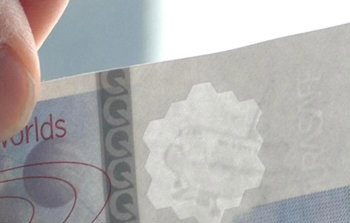
|  |  |  Technology News | December 2009 Technology News | December 2009  
The US Dollar Bill Goes High-Tech
 John Brandon - FOXNews.com John Brandon - FOXNews.com
go to original
December 17, 2009


| | A watermark in a Durasafe bill helps prevent counterfeiting. |  |
Counterfeiting is becoming commonplace. Fortunately, nano threads, color-shifting inks, and even built-in windows are improving our currency.

Counterfeiting has never been easier. All it takes these days is a fairly inexpensive color printer, some graphic design software and a willingness to spend a few decades in jail if you get caught.

But desperate times call for desperate measures, so criminals struggling in a tough economy and savvy with advanced printing equipment have figured out how to replicate bank notes. Some bleach $1 bills and print $100 bills; others use holographic wrapping paper available at any dollar store. And it's not just the little guy. The big guys — the major crime syndicates — have set up complex printing operations to print illegal tender in large quantities.

Fake bills look remarkably similar to the real McCoy, with intaglio (textured printing) and holographic markings.

"Internationally, we have seen a marked increase in counterfeiting in the last five years," says Bonnie Schwab, a consultant who worked for the Bank of Canada and has advised the Central Bank Counterfeit Deterrence Group. "Causes are improvement in technology available to the general public and to the traditional counterfeiters. More and more people with little skill in design and printing are able to download images and print to desktop printers."

Because your basic inkjet printer is constantly improving in output quality, the best way to combat counterfeiting is not to create increasingly intricate designs, but rather to improve the paper it's printed on.

One approach is to make the printing process and substrate — the layer beneath the surface of the paper — more complex and difficult to replicate, even for the pros.

Polymer-based currency, first developed in Australia, has become common and is harder to counterfeit. In 2008, Crane Currency started using a "nano thread" for $100 bills that allows the Bureau of Engraving and Priting to embed new security features, including a strip that becomes visible only when you hold the C-note up to the light.

The U.S. Treasury has taken other measures, including the new $5 bill with its color-shifting ink, an embedded watermark, and a different color that glows for each bill when you hold it up to an ultraviolet light source. Yet according to Schwab, because U.S. bills are so popular all over the world, they are a prime target for counterfeiters, and given enough time and the right technology, criminals tend to learn even the most advanced techniques.

A new option — announced at the Bank Note 2009 Conference in Washington last week — is a hybrid paper called Durasafe, which uses a three-layer substrate made with a polymer core and a 100-percent cotton outer layer.

Made by from Fortress Paper, Durasafe's major advancement is a transparent window that can be any shape and size. Criminals have a hard time replicating these windows because of the complex printing process involved.

"Durasafe uses two substrates with a window in between, so that rules out printers and advanced color copier machines," says Russell Stanley, a financial analyst with Jennings Capital.

Chad Wasilenkoff, the CEO of Fortress Paper, says Durasafe is also designed to last twice as long as traditional banknote paper, which is an attractive option for national banks — especially in the U.S. where, he says, there are as many as 1 million fake bills in circulation. Durasafe-based currency will stay in circulation longer and, Wasilenkoff says, the printing costs will be similar to traditional banknotes.

"Durasafe acts like a sponge for the polymer and improves the tactility of the bank note," says Wasilenkoff, who explained why the touch and feel of a banknote are important for the "level one" security concern, meaning the first point of contact that criminals make. In most cases, counterfeiters pass fake bills off at nightclubs and McDonald's or Starbucks in a chaotic or low-light environment. When a bill just doesn't feel right, the cashier might take the time to inspect the currency.

Vancouver-based Fortress would not comment on which countries may end up using the bills, due to security concerns. But the company says the first mass-produced banknotes that use Durasafe will appear in late 2010.
|

 |
|  |



